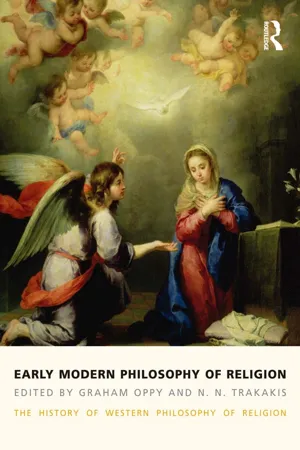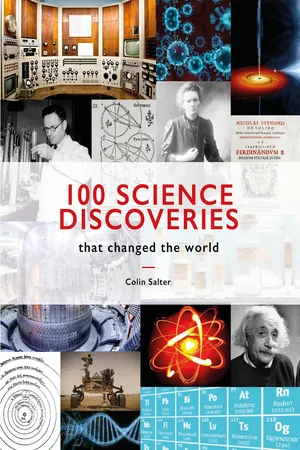Physics
Blaise Pascal
Blaise Pascal was a French mathematician, physicist, and philosopher known for his contributions to the fields of fluid mechanics and pressure. He formulated Pascal's law, which states that a change in pressure applied to an enclosed fluid is transmitted undiminished to all portions of the fluid. His work laid the foundation for the study of hydrodynamics and hydraulic engineering.
Written by Perlego with AI-assistance
3 Key excerpts on "Blaise Pascal"
Learn about this page
Index pages curate the most relevant extracts from our library of academic textbooks. They’ve been created using an in-house natural language model (NLM), each adding context and meaning to key research topics.
- eBook - ePub
Early Modern Philosophy of Religion
The History of Western Philosophy of Religion, volume 3
- Graham Oppy, N. N. Trakakis(Authors)
- 2014(Publication Date)
- Routledge(Publisher)
10 Blaise Pascal William David WetselBlaise Pascal (1623–62) was a towering intellectual figure in seventeenth-century France, the last of the universal geniuses in European history. His discoveries and ideas still have great influence in modern intellectual and scientific life. A true polymath, he made contributions in physics, mathematics, philosophy and theology. Students of physics have heard of Pascal’s vases; students of mathematics know of his triangle. It was he who established experimentally that the weight of the earth’s atmosphere varies according to altitude and first gave theoretical embodiment to the idea of the vacuum. His ideas also gave rise variously to the concept of the calculator or computer and to inexpensive public transportation.In 1646, at the age of 23, Pascal had a profound religious experience when he became associated with a group of disciples of Jean du Vergier, the Abbé de Saint-Cyran, who lived in the vicinity of Rouen. He accepted their doctrine of ‘conversion’ or abandonment of the world and submission to God, and even converted his family to Jansenism. This conversion, however, did not have an immediate effect on his work. One reason was that he became seriously ill in 1647 and returned to Paris, where his physicians advised him to find diversions from his work. That advice led him to relax the religious discipline.Another profound mystical experience occurred in 1654 when Pascal became intimately associated with the Convent of Port-Royal, where his sister Jacqueline had become a religious initiate and where Saint-Cyran was spiritual director. He recorded this second, intense religious experience in his Mémorial (1654). This experience marked Pascal indelibly for the rest of his life, as is evidenced by the fact that the Mémorial , a document of simple physical appearance dominated by lines, dashes and exclamations, was sewn into the lining of his coat. In the following year, 1655, one of the many retreats that Pascal undertook at Port-Royal led to his Conversation with M. de Sacy on Epictetus and Montaigne - Jeremy Stangroom, James Garvey(Authors)
- 2015(Publication Date)
- Arcturus(Publisher)
Blaise Pascal1623–62Blaise Pascal (1623–62) was a man of many talents. In his short life, he made significant contributions to the fields of philosophy, mathematics, physics and theology.WHEN NOT WORKING ON THE MYSTERIES OF THE UNIVERSE , PASCAL ALSO FOUND TIME to invent a calculating machine and to establish an omnibus system in Paris (the profits of which went to the poor). He is generally considered to have been one of the seventeenth century’s best intellects; indeed, many commentators report that even the great philosopher René Descartes was envious of Pascal’s prodigious abilities.It was clear from a very early age that Pascal was going to be something special. His father Etienne, a trained lawyer and brilliant mathematician, with connections to some of the leading scientific thinkers of the age via his association with the Mersenne circle of natural philosophers, took on the task of his son’s education. Blaise was extraordinarily precocious. His sister reports, for example, that by the age of 12 he had managed to work out Pythagoras’s Theorem on his own. His father recognized his talent for mathematics and began to teach him. It was not long before Pascal was participating on his own terms in the discussions of the Mersenne group.The calculating machine was a product of these early years. His father was working as Rouen’s chief tax officer, a job which involved many routine, but time-consuming calculations. Pascal’s machine, with its ability to manipulate numbers of up to six figures, was designed to remove some of the drudgery from the work. Although it proved to be too expensive to make to be a commercial success, it worked correctly, and it is generally considered to be the world’s first geared computer.Thoughts on Vacuum
Also at this time, Pascal was engaged in the scientific work which was to make his international reputation. He had become interested in a set of experiments by Torricelli which showed that when a tube of mercury was placed upside-down in a basin of mercury, a gap appeared at the top of the tube. The issue under debate had to do with what was in the gap. Traditional, scholastic thinkers, remaining true to the Aristotelian adage that nature abhors a vacuum, held that the tube contained some kind of subtle, invisible substance. Pascal’s view was that such matters could not be decided by an appeal to authority, and, with Pierre Petit, he embarked on a series of experiments to determine the truth of the matter.- eBook - ePub
- Colin Salter(Author)
- 2021(Publication Date)
- Pavilion(Publisher)
Euler and Bernoulli worked together on the relationship between blood pressure and the speed of blood flow. Daniel’s particular interest was the theory of conservation of energy – he noted the principle of a change from kinetic to potential energy in a moving body which accompanied a gain in height, and applied it to fluids, in which kinetic energy was exchanged for pressure.Daniel Bernoulli published his magnum opus, Hydrodynamica , in 1738. The name was a word of his own invention and was adopted for the new field of engineering, hydrodynamics, which the book opened up. In it he took the conservation of energy as his starting point and considered the efficiency of hydraulic machines. It contains the first exposition of the kinetic theory of gases.Daniel Bernoulli was actually born in the Netherlands, then under Spanish rule. The talented family of mathematicians moved to Basel in Switzerland to escape Spanish persecution of Protestants.Above all it includes Bernoulli’s Principle, the rule that an increase in the speed of a fluid goes hand in hand with a decrease in pressure or a decrease in the fluid’s potential energy. Leonhard Euler devised the equation that goes with it. Besides its application to hydrodynamic engineering, Bernoulli’s Principle is central to aerodynamics. It is the reason that aeroplane wings have their distinctive cross-section, which encourages lift and flight.Daniel’s father was so jealous of Hydrodynamica that he plagiarized it in his own 1739 book, Hydraulica , which he backdated to 1732 so that it appeared that he, Johann Bernoulli, had thought of Bernoulli’s Principle first. Johann harboured this resentment of his son’s success until the day he died.A pattern of air flow demonstrating the Bernoulli Principle, which states that the internal pressure of a gas is lowered the faster it travels. This principle gives an aeroplane wing lift.Bernoulli’s great work was shamelessly plagiarized by his father.


